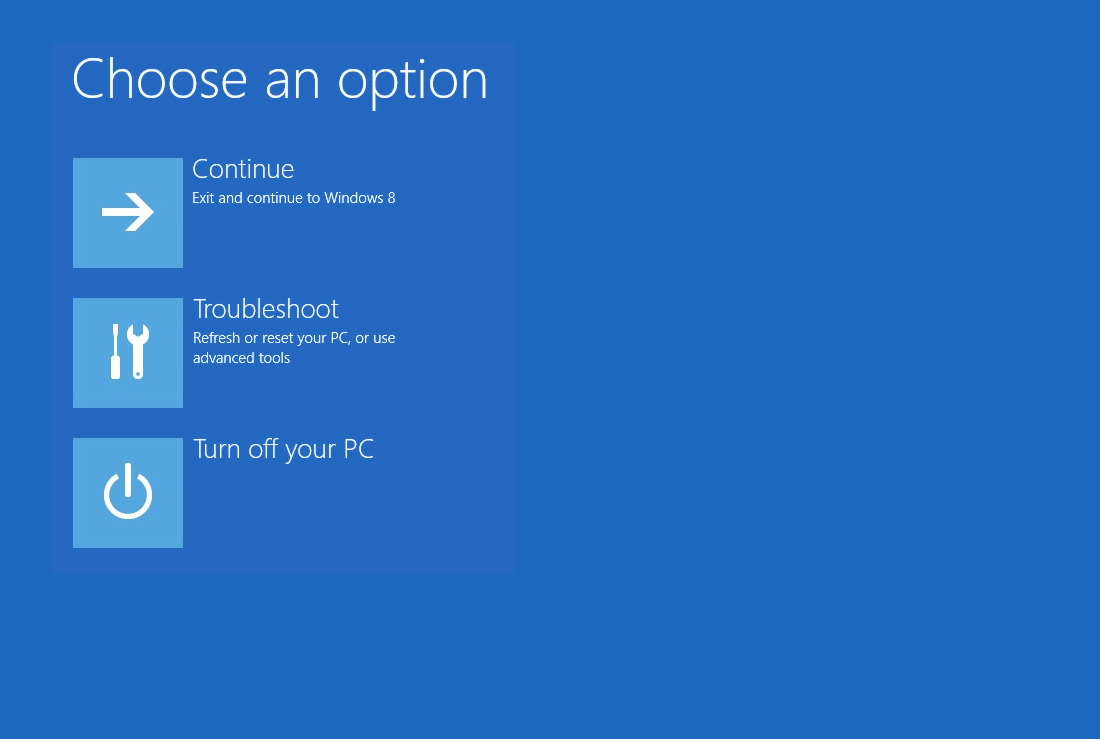How to open system recovery options windows 10 images are available. How to open system recovery options windows 10 are a topic that is being searched for and liked by netizens today. You can Get the How to open system recovery options windows 10 files here. Download all free images.
If you’re looking for how to open system recovery options windows 10 pictures information linked to the how to open system recovery options windows 10 interest, you have pay a visit to the ideal blog. Our website always provides you with suggestions for seeking the maximum quality video and picture content, please kindly hunt and locate more enlightening video content and graphics that match your interests.
This will keep your personal files but itll remove apps and drivers installed after the upgrade as well as any changes you made to settings. For a limited time after upgrading to Windows 10 youll be able to go back to your previous version of Windows by selecting the Start button then select Settings Update Security Recovery and then selecting Get started under Go back to the previous version of Windows 10. This will keep your personal files but itll remove apps and drivers installed after the upgrade as well as any changes you made to settings.
How To Open System Recovery Options Windows 10. For a limited time after upgrading to Windows 10 youll be able to go back to your previous version of Windows by selecting the Start button then select Settings Update Security Recovery and then selecting Get started under Go back to the previous version of Windows 10. This will keep your personal files but itll remove apps and drivers installed after the upgrade as well as any changes you made to settings.
 System Recovery Options Guide For Windows Vista 7 8 8 1 And 10 From neosmart.net
System Recovery Options Guide For Windows Vista 7 8 8 1 And 10 From neosmart.net
For a limited time after upgrading to Windows 10 youll be able to go back to your previous version of Windows by selecting the Start button then select Settings Update Security Recovery and then selecting Get started under Go back to the previous version of Windows 10. This will keep your personal files but itll remove apps and drivers installed after the upgrade as well as any changes you made to settings.
For a limited time after upgrading to Windows 10 youll be able to go back to your previous version of Windows by selecting the Start button then select Settings Update Security Recovery and then selecting Get started under Go back to the previous version of Windows 10.
For a limited time after upgrading to Windows 10 youll be able to go back to your previous version of Windows by selecting the Start button then select Settings Update Security Recovery and then selecting Get started under Go back to the previous version of Windows 10. This will keep your personal files but itll remove apps and drivers installed after the upgrade as well as any changes you made to settings. For a limited time after upgrading to Windows 10 youll be able to go back to your previous version of Windows by selecting the Start button then select Settings Update Security Recovery and then selecting Get started under Go back to the previous version of Windows 10.
 Source: pinterest.com
Source: pinterest.com
For a limited time after upgrading to Windows 10 youll be able to go back to your previous version of Windows by selecting the Start button then select Settings Update Security Recovery and then selecting Get started under Go back to the previous version of Windows 10. This will keep your personal files but itll remove apps and drivers installed after the upgrade as well as any changes you made to settings. For a limited time after upgrading to Windows 10 youll be able to go back to your previous version of Windows by selecting the Start button then select Settings Update Security Recovery and then selecting Get started under Go back to the previous version of Windows 10.
 Source: neosmart.net
Source: neosmart.net
This will keep your personal files but itll remove apps and drivers installed after the upgrade as well as any changes you made to settings. This will keep your personal files but itll remove apps and drivers installed after the upgrade as well as any changes you made to settings. For a limited time after upgrading to Windows 10 youll be able to go back to your previous version of Windows by selecting the Start button then select Settings Update Security Recovery and then selecting Get started under Go back to the previous version of Windows 10.
 Source: pinterest.com
Source: pinterest.com
This will keep your personal files but itll remove apps and drivers installed after the upgrade as well as any changes you made to settings. For a limited time after upgrading to Windows 10 youll be able to go back to your previous version of Windows by selecting the Start button then select Settings Update Security Recovery and then selecting Get started under Go back to the previous version of Windows 10. This will keep your personal files but itll remove apps and drivers installed after the upgrade as well as any changes you made to settings.
 Source: pinterest.com
Source: pinterest.com
This will keep your personal files but itll remove apps and drivers installed after the upgrade as well as any changes you made to settings. This will keep your personal files but itll remove apps and drivers installed after the upgrade as well as any changes you made to settings. For a limited time after upgrading to Windows 10 youll be able to go back to your previous version of Windows by selecting the Start button then select Settings Update Security Recovery and then selecting Get started under Go back to the previous version of Windows 10.
 Source: pinterest.com
Source: pinterest.com
For a limited time after upgrading to Windows 10 youll be able to go back to your previous version of Windows by selecting the Start button then select Settings Update Security Recovery and then selecting Get started under Go back to the previous version of Windows 10. This will keep your personal files but itll remove apps and drivers installed after the upgrade as well as any changes you made to settings. For a limited time after upgrading to Windows 10 youll be able to go back to your previous version of Windows by selecting the Start button then select Settings Update Security Recovery and then selecting Get started under Go back to the previous version of Windows 10.
 Source: in.pinterest.com
Source: in.pinterest.com
For a limited time after upgrading to Windows 10 youll be able to go back to your previous version of Windows by selecting the Start button then select Settings Update Security Recovery and then selecting Get started under Go back to the previous version of Windows 10. This will keep your personal files but itll remove apps and drivers installed after the upgrade as well as any changes you made to settings. For a limited time after upgrading to Windows 10 youll be able to go back to your previous version of Windows by selecting the Start button then select Settings Update Security Recovery and then selecting Get started under Go back to the previous version of Windows 10.
 Source: pinterest.com
Source: pinterest.com
For a limited time after upgrading to Windows 10 youll be able to go back to your previous version of Windows by selecting the Start button then select Settings Update Security Recovery and then selecting Get started under Go back to the previous version of Windows 10. For a limited time after upgrading to Windows 10 youll be able to go back to your previous version of Windows by selecting the Start button then select Settings Update Security Recovery and then selecting Get started under Go back to the previous version of Windows 10. This will keep your personal files but itll remove apps and drivers installed after the upgrade as well as any changes you made to settings.
 Source: neosmart.net
Source: neosmart.net
This will keep your personal files but itll remove apps and drivers installed after the upgrade as well as any changes you made to settings. For a limited time after upgrading to Windows 10 youll be able to go back to your previous version of Windows by selecting the Start button then select Settings Update Security Recovery and then selecting Get started under Go back to the previous version of Windows 10. This will keep your personal files but itll remove apps and drivers installed after the upgrade as well as any changes you made to settings.
 Source: pinterest.com
Source: pinterest.com
This will keep your personal files but itll remove apps and drivers installed after the upgrade as well as any changes you made to settings. For a limited time after upgrading to Windows 10 youll be able to go back to your previous version of Windows by selecting the Start button then select Settings Update Security Recovery and then selecting Get started under Go back to the previous version of Windows 10. This will keep your personal files but itll remove apps and drivers installed after the upgrade as well as any changes you made to settings.
 Source: pinterest.com
Source: pinterest.com
For a limited time after upgrading to Windows 10 youll be able to go back to your previous version of Windows by selecting the Start button then select Settings Update Security Recovery and then selecting Get started under Go back to the previous version of Windows 10. For a limited time after upgrading to Windows 10 youll be able to go back to your previous version of Windows by selecting the Start button then select Settings Update Security Recovery and then selecting Get started under Go back to the previous version of Windows 10. This will keep your personal files but itll remove apps and drivers installed after the upgrade as well as any changes you made to settings.
 Source: pinterest.com
Source: pinterest.com
For a limited time after upgrading to Windows 10 youll be able to go back to your previous version of Windows by selecting the Start button then select Settings Update Security Recovery and then selecting Get started under Go back to the previous version of Windows 10. This will keep your personal files but itll remove apps and drivers installed after the upgrade as well as any changes you made to settings. For a limited time after upgrading to Windows 10 youll be able to go back to your previous version of Windows by selecting the Start button then select Settings Update Security Recovery and then selecting Get started under Go back to the previous version of Windows 10.
This site is an open community for users to do sharing their favorite wallpapers on the internet, all images or pictures in this website are for personal wallpaper use only, it is stricly prohibited to use this wallpaper for commercial purposes, if you are the author and find this image is shared without your permission, please kindly raise a DMCA report to Us.
If you find this site serviceableness, please support us by sharing this posts to your favorite social media accounts like Facebook, Instagram and so on or you can also bookmark this blog page with the title how to open system recovery options windows 10 by using Ctrl + D for devices a laptop with a Windows operating system or Command + D for laptops with an Apple operating system. If you use a smartphone, you can also use the drawer menu of the browser you are using. Whether it’s a Windows, Mac, iOS or Android operating system, you will still be able to bookmark this website.





